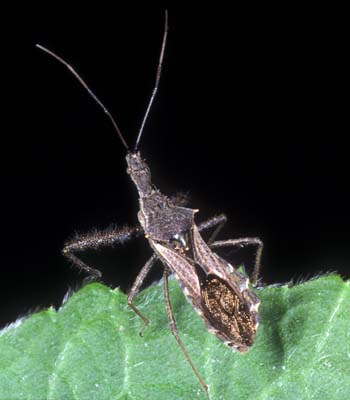
Adult Sinea diadema, an assassin bug.
(Photographer: Lyle Buss, University of Florida)
These predatory bugs belong to a very large group of hemipterans with more than 160 North American species. Both males and females of the same species are similar in appearance (females are longer and wider than males). These insects are usually blackish or brownish in color, but there are many brightly colored species. Assassin bugs are 1.3 to 3.7 cm in length, while most ambush bugs are 1.3 cm or less. Both groups are robust or stout-bodied. Their abdomens are usually widened in the middle, exposing the lateral margins of segments beyond the wings. The head is usually elongate and the area behind the eyes is constricted to form a "neck." These bugs have long legs and their heads possess stout beaks. While assassin bugs usually possess long, thin antennae, those of ambush bugs are shorter and stouter.
Eggs are bottle-like in shape, brown in color and are covered with a conspicuous cap. These eggs are usually laid on end, side by side, in hexagonal clusters. Egg masses are found near the ground attached to tree trunks and limbs, shrubs and other objects. Nymphs are usually soft bodied and are brightly colored (green, red, tan, etc.) with distinct markings that range from red to black in color.
It takes about three months for these bugs to complete their life cycles. Once the eggs hatch, the nymphs undergo five instars until they reach the adult stage. Adults are found during the spring and summer months.
These insects are found in wooded or grassy areas, on flowers and trees, and in cellars and barns throughout the United States.
Assassin bugs feed on flies, caterpillars and other insects. At least one species, the masked hunter, feeds on bed bugs but also bites people. The wheel bug, common in the eastern United States, also can deliver a painful bite to people if handled.
Ambush bugs feed feed mostly on bees, wasps and flies, which they capture by lying in wait on flowers.
Images
To save the Web-optimized images shown below to your hard drive:
|
Click to access Display and Print quality images. |
|
Click to access Display and Print quality images. |
|
Click to access Display and Print quality images. |
|
Click to access Display and Print quality images. |
|
Click to access Display and Print quality images. |
|
Click to access Display and Print quality images. |
|
Click to access Display and Print quality images. |
|
Click to access Display and Print quality images. |